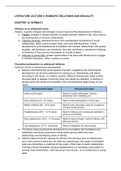LITERATURE LECTURE 9. ROMANTIC RELATIONS AND SEXUALITY
CHAPTER 10. INTIMACY
Intimacy as an adolescent issue
Puberty, cognitive changes and changes in social roles and the development of intimacy
● Puberty: changes in sexual impulses at puberty provoke interest in sex, which lead to
the development of romantic relationships.
● Cognitive changes: adolescents have more sophisticated conceptions of social
relationships, better communication skills, and more self-awareness. These
developments permit adolescents to establish and maintain relationships with greater
empathy, self-disclosure, and sensitivity: they also contribute to adolescent’s feelings
of loneliness if they perceive themselves as socially isolated.
● Changes in social roles: greater opportunities to be alone with friends and to engage
in intimate discussion, either in person or online.
Theoretical perspective on adolescent intimacy
Sullivian’s theory of interpersonal development
● Sullivan emphasized the social aspects of growth, suggesting that psychological
development can be best understood by looking at our relationships with others.
According to this theory, as children develop, different interpersonal needs surface
that lead either to feelings of security (when the needs are satisfied), or feelings of
anxiety (when the needs are frustrated). Early developmental stage brings its own
needs.
Developmental stages Interpersonal needs
Infancy (0-2/3 years) Need for contact with people, need for
tenderness from mothering one.
Early childhood (2/3 - 6/7 years) Need for adult participation in child’s play.
Middle childhood (6/7 - 8/10 years) Need for peer playmates, need for acceptance
into peer society groups.
Preadolescence (8/10 - 12/14 years) Need for intimacy and consensual validation in
same-sex chumships.
Early adolescence (12/14 - 17/18 years) Need for sexual contact, need for intimacy with
other-sex partner.
Late adolescence (17/18 - adulthood) Need for integration into adult society.
● The theory views psychosocial development as cumulative: the frustrations and
satisfaction individuals experience during earlier periods affect their later
relationships and developing sense of identity.
● Sullivan believed that the capactiy for intimacy first develops prior to adolescence
and in the context of same-sex not other-sex relationships: the quality of indivdual’s
same-sex friendships is predictive of the quality of their later romantic relationships.
Forming intimate friendships during preadolescence is a necessary precondition to
forming close relationships - both sexual and non-sexual - as an adolescent or young
adult.
, ● Sullivan saw adolescence as a time of experimentation with different types of
relationships, and he saw this experimentation as a normal way of handling new
feelings, new fears, and new interpersonal needs.
The attachment theory
Attachment is defined as the strong affectional and emotional bond that develops between
an infant and a caregiver. The theory differentiates among four types of infant attachment:
● Secure attachment: a healthy attachment between infant and caregiver,
characterized by trust.
● Anxious-avoidant attachment: an insecure attachment between infant and
caregiver, characterized by indifference on the part of the infant toward the caregiver.
● Anxious-resistant attachment: an insecure attachment between infant and
caregiver, characterized by distress at separation and anger at reunion.
● Disorganized attachment: a relationship between infant and caregiver
characterized by the absence of normal attachment behavior (highest risk group).
The attachment theory has given rise to two different, but related, questions about
adolescent development:
1 - Is there a link between the quality of attachment formed in infancy and mental health or
behavior adolescence?
● Some theorists have argued that the initial attachment relationship forms the basis
for the model of interpersonal relationships we employ throughout life: the internal
working model. This internal working model determines to a large measure whether
people feel trusting or apprehensive in relationships with others and whether they
see themselves as worthy of other’s affection. According to this, individuals who
enjoyed secure attachment relationships during infancy will have a more positive and
healthy internal working model of relationships during adolescence.
● In addition, some theorists have argued that interpersonal development is
cumulative: what happens during infancy affects what happens in early childhood,
and so forth. So individuals who leave infancy with a secure attachment may be on a
different interpersonal trajectory than those who leave infancy insecure. For example,
secure infants are more likely to grow into socially competent teenagers and young
adults.
2 - Can the same three-category framework used to characterize attachment in infancy
(secure, anxious-avoidant, anxious-resistant) be used to characterize interpersonal
relationships in adolescence?
● To examine this, the adult attachment interview can be used. The interview
focuses on individuals' recollections of their early attachment experiences,
obtains information on the ways in which the individual recounts his or her
childhood history, and their internal working model of relationships.
Afterwards, respondents are coded as secure, dismissing or preoccupied.
People’s security of attachment in infancy predicts social competence in
childhood, security of attachment to close friends in adolescence, and
positive romantic relationships in adulthood (infant attachment → peer
competence → security at 16 → adult romantic relationships quality).
● However, some studies also have looked at the quality of adolescents' current
attachments to parents and peers.
, ○ Secure attachments during adolescence are more socially competent, more
successful in school, less likely to engage in substance use, and better
adjusted.
○ Adolescents’ attachment to their mother is typically more secure and more
important, and attachment to their father less so, over the entire adolescent
period.
○ Security of attachment predicts whether and at what age adolescents “leave
the nest”: insecurely attached adolescents are more likely to delay moving out
or to return to their parents’ home.
● Early attachment security, however, is not an inoculation that protects individuals
from psychological problems forever, but rather a psychological advantage that
increases the probability of developing in healthy ways.
The development of intimacy in adolescence
Changes in the nature of friendships
● Consistent with Sullivan’s theory, the conceptions of friendship in adolescence put
more weight on intimacy, loyalty, and shared values and attitudes. This is also
consistent with what we know about other cognitive changes during adolescence:
adolescents are better at thinking about abstract concepts, such as intimacy and
loyalty.
● An interesting pattern of change occurs at around age 14: concerns about loyalty and
anxieties over rejection become more pronounced and may temporarily overshadow
concerns about intimate self-disclosure. Girls in particular show a pronounced
increase in jealousy over their friends’ friends during early adolescence. Especially
when they have low self-esteem and are high in rejection sensitivity.
● Another interesting pattern of change occurs in adolescence: the type of conflicts
they have and the ways in which disagreements are resolved. Arguments with close
friends are more emotional with lots of anger and hurt feelings.
Changes in the display of intimacy
● Adolescents know significantly more things about their friends that are intimate. Also,
over the course of adolescence, adolescents’ reports of friendships quality increase
steadily. This lead to gains in social competence and increases in positive affect,
creating an upward spiral. Adolescents also become more responsive to close
friends, less controlling, and more tolerant of their friends’ individuality.
● The ways in which close friends resolve conflict also change: they become more
likely to end their disagreements by negotiation or disengagement and less likely to
end them with one person coercing or overpowering.
Social media
● Despite all the concerns, some scientists believe that using social media may
actually help teenagers develop social competence. It enhances the quality of
adolescents’ friendships. Furthermore, social media provide opportunities to engage
in many of the same activities that adolescents do in person, without compromising
these relationships.
● Digital communication serves an important purpose in helping teenagers validate the
importance of their friendship, through showing each other affection. Also, digital
, communication has provided new ways for adolescents to enjoy their friends’
companionship.
Sex differences in intimacy
● Girls show more intimacy in their friendships and they value it a lot more than boys
do. Girls are also more sensitive and empathic than boys. Girls value friendships
characterized by emotional support and concern; boys place a premium on having
fun.
● Girls’ mental health is more positively affected than boys’ when things are going well
with their friends, but they are also more likely than boys to spend excessive time
discussing each other's problem: co-rumination, which can lead to depression and
anxiety, although it also leads to better friendship quality.
● Boys’ conflicts are briefer, typically over issues of power and control, more likely to
escalate into physical aggression, and usually resolved without any explicit effort to
do so.
● Despite all these differences, boys and girls report equivalent degrees of intimate
knowledge about their best friends. However, they may express intimacy differently:
through shared activities.
Changes in the targets of intimacy
● While peers become relatively more important as confidants and sources of
emotional support, by no means do parents become unimportant. Adolescents who
are not intimate with their parents, often feel lonely, and do not experience the
normal adaptive reaffiliation motive that most of us have, which prompts us to
reconnect with others when we feel lonely.
● The quality of adolescent-parent relationships and marital relationships is closely
linked. This provides support for both social learning and attachment-based views of
adolescent intimacy: the lessons young people learn in close relationships at home
provide a template for the close relationships they form with others.
Differences between parent- and peer intimacy in adolescence
● Parent-adolescent relations are characterized by an imbalance of power.
Adolescents’ interactions with their friends are more mutual and balanced.
● Intimacy with parents provides opportunities to learn from those older and wiser,
intimacy with friends provides opportunities to share experiences with individuals who
have a similar perspective and degree of expertise.
Other individuals with whom adolescents can be intimate with
● Siblings: adolescents are less intimate with siblings than with their parents or friends.
Conflicts may decrease during adolescence, due to the fact that they spend less time
together.
● Extended family members: slight increase in childhood, but a drop in adolescence in
intimacy. However, not in divorced families: divorce is associated with increased
contact between adolescents and their grandparents.
Other-sex friendships
● The intimacy between adolescents boys and girls is relatively slow to develop and
generally tinged with an air of sexuality. When this happend, it is not the case that
intimate friendships between adolescents of the same sex are displaced by the
emergence of intimacy between adolescent males and females.






